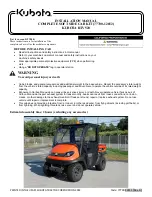
SECTION 10 -- ENGINE -- CHAPTER 1
10-39
Compression Test
In case of poor engine performance, in addition to
checking the fuel injection system (injection nozzles
and injection pump), also test the compression on
each cylinder.
DANGER
Do not use matches, lighters, blowtorches or any
form of naked flame as a source of light when
inspecting the engine due to the presence of
inflammable fluids and vapor.
Compression ratio
The compression ratio is a measure of the quantity
of air drawn into the cylinder, and provides an
indication of the efficiency of the sealing elements in
the cylinder (piston rings and valves).
Uniform compression in all the cylinders ensures that
they all perform an equal amount of work, provided
that each cylinder is injected with the same quantity
of fuel at the right time.
Low compression not only reduces engine perfor-
mance, it also causes incomplete fuel combustion
due to the lack of available combustion air.
The engine therefore gives poor performance with
excessive fuel consumption and, consequently,
exhaust smoke and restriction of the exhaust
passages.
As the compression ratio
also varies with the
temperature of the engine
( cold engines produce
lower compression values than hot engines), the
compression should only be tested when the engine
is at normal operating temperature.
Compression should be tested using the compres-
sion test kit
380000303,
as follows:
1) run the engine until it reaches normal operating
temperature;
2) switch off the engine;
3) disconnect the lead from the engine stop
electromagnet on the injection pump in order to close
the valve, and block the flow of fuel to the injectors;
4) remove the injector from the cylinder to be tested;
5) turn the engine over a few times with the starter
motor in order to expel any carbon residue;
6) fit the dummy injector
380000617
in place of the
injector removed previously, interposing the copper
sealing washer;
7) connect the compression test instrument
380000303
and take readings while turning the
engine over with the starter motor.
On engines in perfect working order, with the sump
oil at approximately 40
o
C (104
o
F) at sea level (760
mm [29.9212 in, mercury]) and at an engine speed of
200 to 280 rpm, the compression should be 25.5 to
27.5 bar (369.8 to 398.8 psi).
8) Test the compression on the other cylinders,
repeating steps 4--5--6--7, bearing in mind that:
The minimum permissible compression on a used
engine is 21.6 bar (313.2 psi).
The maximum permissible compression difference
between cylinders is 3 bar (43.5 psi).
Every 100 meters (109.36 yards) above sea level
corresponds to a reduction in compression by
approximately 1%.
Considerations:
Uniform compression
Although high compression is important, it is more
important for smooth engine running that compres-
sion is uniform in all cylinders.
Low compression readings
If extremely low pressure readings are obtained on
one cylinder it is advisable to repeat the test.
Before testing this time, pour approximately one
spoonful of engine oil into the cylinder through the
injector bore.
Turn over the engine a few times to distribute the oil
evenly over the cylinder walls, and then repeat the
test.
If the second test readings are significantly higher,
suspect worn piston rings, out-of-round or damaged
pistons.
If the second test readings are not higher, the
problem will be the valves.
On the other hand, if the second test reading shows
only a slight improvement, the problem will be due to
both the valves and the rings.





















